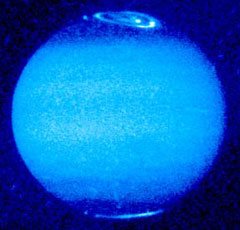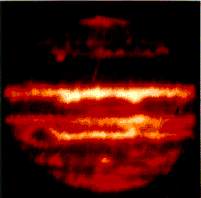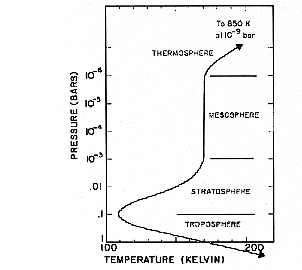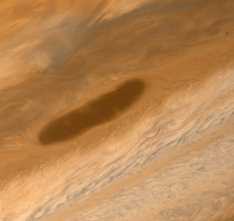This is an infrared image of Jupiter showing regions which are hot.
Click on image for full size
NASA
The Source of Heat from Within Jupiter
Frequently in astromony, the luminoscity of a star is calculated. The luminoscity indicates the energy, and the temperature of the star.
When the luminoscity of the outer planets was calculated, that of Jupiter and Saturn was very high, indicating that these planets are giving off a lot of energy, more energy in fact than they are receiving from the sun.
There are several ways in which astronomical objects produce energy from inside. The first is thermonuclear fusion. This method of energy production is reserved for stars. Another method is by way of radioactive material within the ground. This method is at work in most terrestrial bodies.
For the giant planets the method which seems to be at work is the mere fact that energy is given off from when a planetary body is in the process of shrinking together, or collapsing on itself.
The fact that Jupiter is still collapsing together indicates that the process of planet formation is still going on. This process is providing the heat from within which causes the unusual motions in the atmosphere.
You might also be interested in:

Some materials give off radiation. We say that those substances are "radioactive". Radioactive materials are often, though not always, hazardous to living things. There are many different types of radioactive
...more
Motions, or currents in the interior of a gas-giant planet such as Saturn may be very different from the motions typical of the earth's interior. A second idea for the motions in the interior of a gas-giant
...more
Motions in the interior of a planet help carry heat from the inside to the outside. The drawing to the left illustrates a kind of global motion that is typical of motions in the atmosphere as well as the
...more
The Giant planets do not have the same layered structure that the terrestrial planets do. Their evolution was quite different than that of the terrestrial planets, and they have less solid material inside.
...more
Several interesting phenomena are found at the poles of Jupiter, the largest planet in our Solar System. Three of Jupiter's four large "Galilean" moons are ice-covered and thus reminiscent of Earth's polar
...more
Frequently in astromony, the luminoscity of a star is calculated. The luminoscity indicates the energy, and the temperature of the star. When the luminoscity of the outer planets was calculated, that of
...more
This is the temperature profile of Jupiter's entire atmosphere. The horizontal lines indicate the boundaries between the troposphere, the stratosphere, the mesosphere, and the thermosphere.
...more
This is a picture of a brown barge. The accompanying clouds, next to the barge, look very similar to earth clouds.
...more














